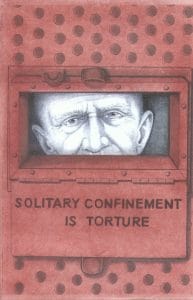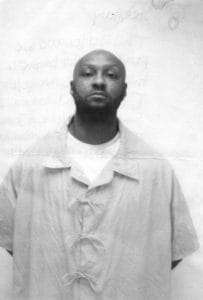by Mwalimu Siri Shakur
I wake up every morning and stretch, then say a prayer thanking the Lord for allowing me to make it through another day and night. My mattress is in real poor condition, as it’s old and the cotton is coming out, so I’ve had to re-sew it in order not to further damage my back. I spend at least 20 minutes every morning stretching, then brush my teeth and wash my face.

This starts at 5 a.m. I roll up my mattress and use it for a couch by propping it up against the wall, then fold my blanket and sheets and use them to sit on. I make me a cup of hot coffee, and afterwards an hour has passed by.
I proceed to exercise. My exercise routine depends on what day it is. From Monday to Wednesday, I start off with power workouts: 100 push-ups, 100 squats, 100 lunges and 300 backarms. Thursday and Friday, I do cardio.
This eliminates stress and allows me to stay focused on my routine and not the noise from the fans that blow in our dayroom or the wellness checks that are performed by the correctional officers every 30 minutes. (The wellness checks consist of the correctional officers going door to door with a little metal wand that, once it touches the little button on your door, makes a beeping sound.)
I start off with 100 jumping jacks, then go into some military-style push-ups called burpies. This is a constant motion where I go down into a push-up position, do three, four, five, etc., then come back up to a standstill and proceed again. I do 50 five-counts, then 100 squats, then 50 four-counts, then 100 harbor steps, then 50 three-counts.
By then I’m finished and it’s breakfast time, and the light comes on in my cell and in the dayroom. After I say good morning to the correctional officer (CO) who’s unlocking my tray slot, I cover up my window and take everything off the floor so I can take my bird bath.
This we do in the form of a makeshift shower, where we can fill up the sink with water, lather up our whole body with soap, then use a cup to pour water all over ourselves to rinse, or use a hose to put in the nozzle of our water-head and let it come out in a spray. Either way, it gets the job done beautifully.
After this process, I clean up the cell with the water and some shampoo. The floor, the walls, and my door, so my cell gets clean and smells clean. After that, the breakfast arrives and it’s never hot, and always cold, especially if served on a paper tray.
The food is usually bland and not enough to keep you full, so I only eat certain things, and if I want to get full, I’ll make use of my canteen items, such as oatmeal, rice and beans and top ramen noodles. On the breakfast tray I only like the oatmeal or grits, the pancakes and waffles, and the eggs and potatoes because they’re always prepared well. We also get our lunch at the same time, in a brown paper bag, but I usually eat it much later in the day.
I wake up every morning and stretch, then say a prayer thanking the Lord for allowing me to make it through another day and night.
Next it’s my study time, and it can last for at least three to four hours daily. I enjoy the various subjects of economics, political science, history and philosophy, just to name a few. The works of Karl Marx, Friedrich Engels, V.I. Lenin, Chairman Mao and George L. Jackson have my attention deeply as I’ve found dialectical materialism to be a very helpful tool in understanding and applying theory to my day-to-day practice.
If we have any movement, as in yard time or medical, it’s always in hand restraints, or waist chains under a two-guard escort. All movement is done this way, even to the shower, where we only get 10 minutes to shave and can only come out of our cells in our boxer shorts and shower shoes three times a week. Yard time is similar, except yard is three hours, three times a week, where we’re in cages (individually) with a little sink-and-toilet combination like in our cells.
This allows us a little social interaction with other inmates, with whom we can engage in conversation and/or exercise. I enjoy watching the little birds play, or if it’s springtime or summer, watching a gopher pop out of his hole. Sometimes one of the maintenance workers will be cutting the grass that’s in front of all the buildings. I like the smell of fresh-cut grass. This makes me remember when I was a kid and the gardener used to cut our grass at my grandmother’s house.
Anything we receive gets delivered to our cell doors, like canteen once a month, mail, books, medicine for our illnesses, and anything we can now order from the catalogues the COs give us, like our TVs, radios and yearly packages. We are locked in our cells 24 hours a day.
Sometimes I don’t go to yard, or shower, because I’ve been accustomed to them taking that part of our program, like so many others who’ve spent years back in these slave tombs we call SHU. The oppressors call solitary confinement the place where the worst of the worst, the most dangerous and violent inmates, are housed. The truth of the matter is, our oppressors make men violent with their form of antagonistic ways of mistreatment, and/or demonstrations of psychological warfare that they display to provoke a man.
Sometimes I don’t go to yard, or shower, because I’ve been accustomed to them taking that part of our program, like so many others who’ve spent years back in these slave tombs we call SHU.
They’d like to do nothing more than strip you of your humanity. They house men in the SHU who are revolutionaries, political prisoners and those who resist fascist practices by the imperialists.
We do not allow subjective sentiment to rule or control us. When they take our yard and shower program, the excuses are always the same: something happened on the yard, or a bus came, or they’re running committee and have a lot to do, lack of staff, etc., etc.
Surviving solitary
A SHU cell is all concrete. The doors on the bottom tier are all metal with two long windows you can look out of if need be. The top tier has a metal door as well, but it has holes all over it, like a honeycomb, so you can get the air that blows from the two fans in the dayroom. You can feel the air on the bottom tier, at the bottom of the door.

Out our doors we can see our tower officer, and we can see the COs bringing our food. We can see the two sets of stairs that lead to the top tier, and the fire hose in its case on the wall. Our tower windows have a two-way mirror so we can see the top-tier cells and the shower. Now maintenance has made it so we can turn our own lights on and off.
Some people play chess in their cells with their neighbors, either on the vent where we can talk to each other, or out of the door. The top tier has screen doors and it’s not that hard to hear, but you do have to talk louder because of the fans. On the lower tier, you can talk at the bottom of your door or out the side of your door. You can communicate like this from bottom tier to top tier, especially in the vents.
Life in the SHU is what you make out of it, and when making the best of a bad situation, you tend to be creative in ways that give you mental stimulation. But make no mistake about it: Long-term isolation has a lot of psychological and physical downsides to it.
There are people in here who look as if they’ve aged ten years when you see them. Some have canes and walkers; some take psychotropic medication. Almost everyone wears eyeglasses and has high blood pressure, diabetes, cancer or other serious illness. Solitary confinement and its inhumane practices need to be abolished.
Surviving solitary confinement is not an easy task because the very nature of it is designed to break a man’s will to resist authority. One can be placed in solitary confinement for any number of things, such as being a jailhouse lawyer (helping inmates with their legal cases), behavior problems where physical altercations take place with staff or other inmates, or for political beliefs and religious practices common among the Afrikan Amerikkkan prisoners.
Life in the SHU is what you make out of it, and when making the best of a bad situation, you tend to be creative in ways that give you mental stimulation. But make no mistake about it: Long-term isolation has a lot of psychological and physical downsides to it.
Solitary confinement is a practice the prison-industrial slave complex uses to create the criminal mentality, due to there being no rehabilitation, which would in fact undermine the government’s endeavors to politically and economically exploit the Afrikan Amerikkkan community via poverty and crime. This will enhance criminal behavior, which derives from the long-term isolation. Think animals in the zoo or dogs in the dog pound.
Surviving solitary confinement is not an easy task because the very nature of it is designed to break a man’s will to resist authority.
The need to abolish solitary confinement is upon us. Its practice does no good to the human mind. It’s the epitome of evil that can destroy a person mentally and psychologically. When I think of its use, the Willie Lynch theory of slave-breaking comes to mind. People, this is a crime against humanity. The struggle continues until all oppressed are free …
Send our brother some love and light: Mwalimu Siri Shakur, s/n Terrance E. White, AG-8738, Corcoran State Prison SHU 4A-4R-26, P.O. Box 3476, Corcoran, CA 93212.





